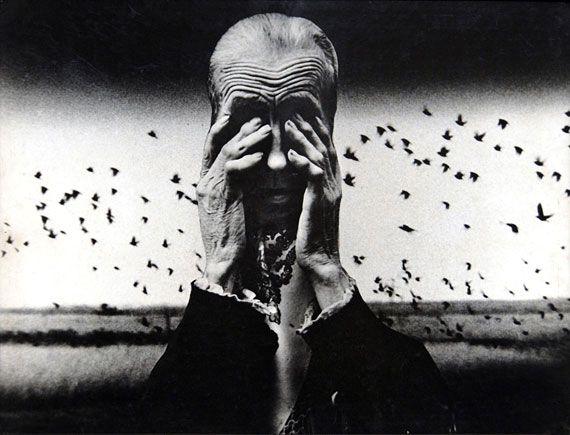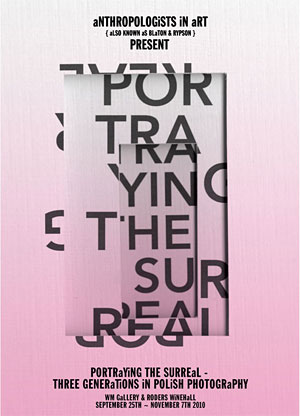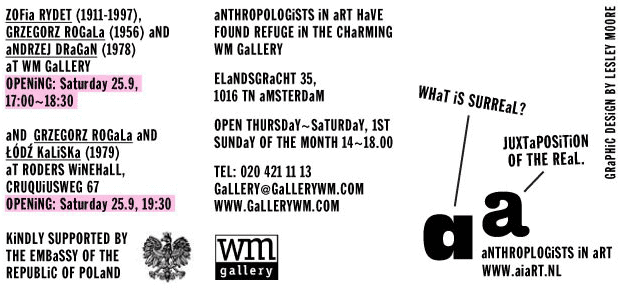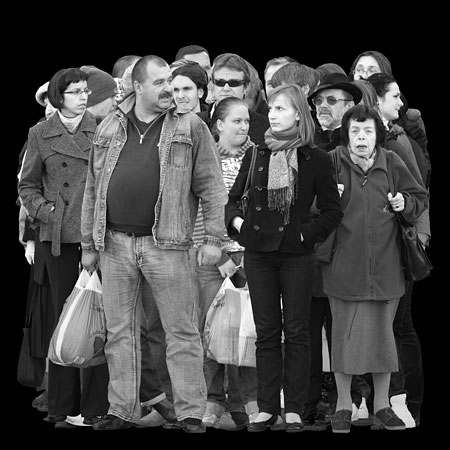Zofia Rydet, Grzegorz Rogala, Andrzej Dragan “Portraying the Surreal, three generations in Polish Photography 25.09 – 24.10.2010
September 25, 2010 11:56 pm
 Zofia Rydet ‘Cycle Annihilation’ 1970“Portraying the Surreal, three generations in Polish Photography”Zofia Rydet (1911-1997), Grzegorz Rogala (1956) and Andrzej Dragan (1978) at WM Gallery Opening: Saturday 25.09; 17.00-18.30 and Grzegorz Rogala and Lodz Kaliska (1979) |
Blaton & Rypson, Anthropologists in Art zijn trots om te presenteren: Portraying the Surreal, three generations in Polish Photography Zofia Rydet (1911-1997), Grzegorz Rogala (1956), Andrzej Dragan (1978) in WM Galleryen Grzgeorz Rogala (1956) en Lodz Kaliska(1979) in Wijnterminal Cruquius-eiland 25/09/2010 t/m 24/10/2010  |
| As part of the GRID2010 Photography Biennale in and around Amsterdam, WM Gallery will be representing Polish photography. Curators Blaton & Rypson have opted to present a unique selection of the surreal through time.
Invited are: the grande dame of Polish photography Zofia Rydet (1911-1997),Grzegorz Rogala (1956) and Andrzej Dragan (1978). Together they represent three generations within Polish photography where the surreal meets the innovative. Zofia Rydet is famous for her ethnographic photography of Polish society (the so-called ‘Polish Sociological Photography’). Her photography has won wide acclaim and is part of the collections of the Centre G. Pompidou (Paris), MOMA (New York) and the Museum of Modern Art Kyoto (Japan), amongst others. The works presented by curators Blaton & Rypson distinguish themselves both by the technique used: collages of cut-up images on the one hand, and by the surreal compositions that leave a penetrating and poignant impression, on the other. The youngest of the three photographers, Andrzej Dragan, may be considered as one of Poland’s rising stars, who has already won wide acclaim and numerous awards in Europe with his ‘edited’ photography. Dragan modifies photographs of many, often-time, famous personalities such as Marlyn Monroe and Adolf Hitler pixel by pixel, whereby a transformation in image and time takes place, creating a surreal reality. This leaves a paradoxical conundrum that both attracts and repels at the same time. Grzegorz Rogala’s work finally, complements the exhibition. Departing from his previous multi-layered series “Mothers, Sisters, Fathers”, in which multiple-exposure produced non-existing personalities resonant with nostalgia, Rogala has now developed light-boxes which he calls “Moving Pictures”. Grzegorz Rogala reflects on the nature of time. Applying lenticular photography (whereby the image changes according to the angle of the viewer), he achieves the impression of space (a 3D type of effect) and movement, bringing it closer to film and animation. With Rogala, what you see is not what you get.
Besides the aforementioned representatives of Polish photographic surrealism, the artistic group Lodz Kaliska cannot be omitted. Aside from the innovative installation by Grzegorz Rogala (“Pedestrians’), Anthropologist in Art and WM Gallery present this unparalleled influential artistic group in the Wine Terminal on the Cruquiusweg during the official opening of the country-exhibition. Lodz Kaliska was founded in 1979 and has since established its place in the contemporary Polish art scene. At this moment the artists Andrzej ‘Makary’ Wielogorski, Marek Janiak, Andrzej Swietlik and Adam Rzepecki form the artists’ collective. Their years-long activity, which significantly preceded what is now called critical art in Poland, has always had strong opponents and critics, as they never yielded to the prevailing styles and trends. Simultaneously, their unconventional activities, bordering on performance art and the theater of the absurd, also won them many fans and followers. They deal with photography in a very peculiar way, being the only group that has been consistent in realising the program of staged photography. Alongside older works from the 80s and 90s, they will also present two panoramic photographs from their latest project; ‘May Men Rot’ (Niech Szczezna Mezczyzni). |
Als onderdeel van de Fotografie Biënnale GRID2010 in en rond Amsterdam, zal WM Gallery Poolse fotografie vertegenwoordigen. Curatoren Blaton & Rypson hebben gekozen voor een unieke selectie van het surreële door de tijd heen.Uitgenodigd zijn: de grande dame van de Poolse fotografie Zofia Rydet(1911-1997), Grzegorz Rogala (1956) en Andrzej Dragan (1978). Samen vertegenwoordigen zij drie generaties binnen de Poolse fotografie waarvan het surreële en het innovatieve elkaar bindt. Zofia Rydet is bekend om haar etnografische fotografie van de Poolse samenleving (de zgn. ‘Polish Sociological Photography’). Haar fotografie is wereldwijd geroemd en behoort tot de collectie van onder andere Centre G. Pompidou (Parijs), MOMA (New York) en Museum of Modern Art Kyoto (Japan). De werken die curatoren Blaton & Rypson presenteren onderscheiden zich enerzijds door de gehanteerde techniek: collages van verknipte foto’s, anderzijds door de surreële composities die een indringende en aangrijpende indruk achterlaat. De jongste van de drie fotografen, Andrzej Dragan, kan beschouwd worden als één van Poolse aanstormende talenten die binnen Europa reeds furore begint te maken met zijn ‘bewerkte’ fotografie. Dragan bewerkt foto’s van veelal bekende persoonlijkheden als Marlyn Monroe en Adolf Hitler pixel voor pixel, waardoor er een transformatie in beeld en tijd plaatsvindt die een surreëele werkelijkheid tot leven roept. Het creëert een paradoxaal raadsel die zowel aantrekt als afstoot. Grzegorz Rogala’s werk complementeert de tentoonstelling. Vertrekkend vanuit zijn eerdere multi-gelaagde serie “Mothers, Sisters, Fathers”, waarbij multiple exposure niet-bestaande persoonlijkheden produceerde die resoneerde van nostalgie, heeft Rogala inmiddels licht-bakken ontwikkeld die hij “Moving Pictures” noemt. Grzegorz Rogala reflecteert over de aard van de tijd. Met toepassing van lenticulaire fotografie (waarbij het beeld verandert naargelang de hoek van de kijker), wekt hij de indruk van de ruimte (een soort 3D-effect) en beweging, die dichter bij film en animatie dan bij fotografie staat. Met Rogala, is wat je ziet niet wat je krijgt. Naast de bovengenoemde representanten van Pools fotografisch surrealisme, mag de artistieke groep Lodz Kaliska niet ontbreken. Naast een innovatieve installatie van Grzegorz Rogala (‘Pedestrians’), presenteren Anthropologists in Art en WM Gallery deze ongeevenaard invloedrijke artistieke groep in de Wijnterminal aan de Cruquius weg tijdens de officiele opening van de landen-tentoonstelling. Lodz Kaliska werd opgericht in 1979 en heeft sindsdien haar vaste plek in de hedendaagse Poolse kunstscène gevonden. Op dit moment maken de kunstenaars Andrzej ‘Makary’ Wielogorski, Marek Janiak, Andrzej Swietlik en Andrzej Rzepecki deel uit van het kunstenaars-collectief. Hun jaren-lange activiteit, die aanzienlijk voorafging aan wat nu in Polen zogenaamde kritische kunst wordt genoemd, heeft altijd sterke tegenstanders en critici gehad, omdat zij nooit zwichtten voor de heersende stijlen en stromingen. Tegelijkertijd, grensde hun onconventionele activiteiten zo aan performance kunst en de theater van het absurde dat ze ook veel liefhebbers voor zich wonnen. Ze behandelen fotografie op een zeer eigenaardige manier, de enige groep zijnde die consistent geweest is in het realiseren van het programma van de geënsceneerde fotografie. Naast oudere werken uit de jaren ’80 en ’90, worden ook twee panorama-foto’s getoond van hun laatste project ‘May Men Rot’ (Niech Szczezna Mezczyzni |
 Lodz Kaliska |
 |
|
|


